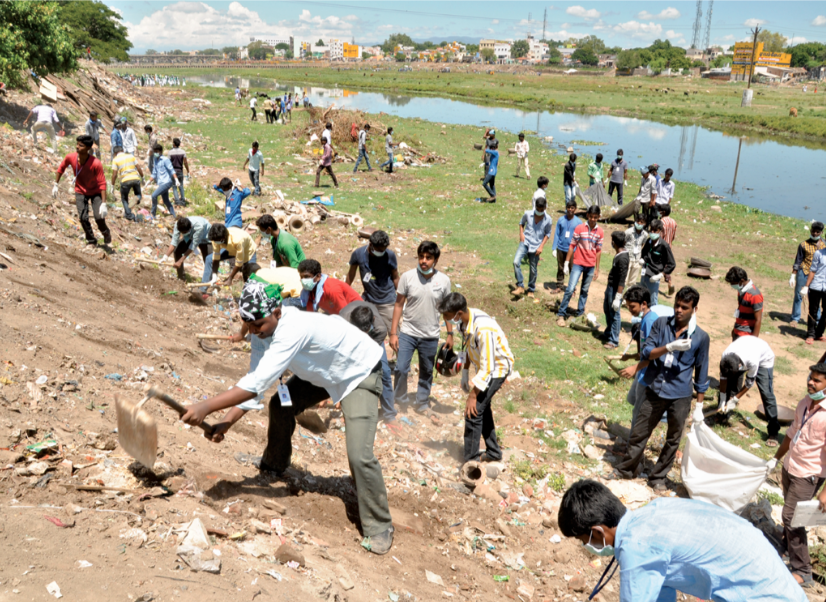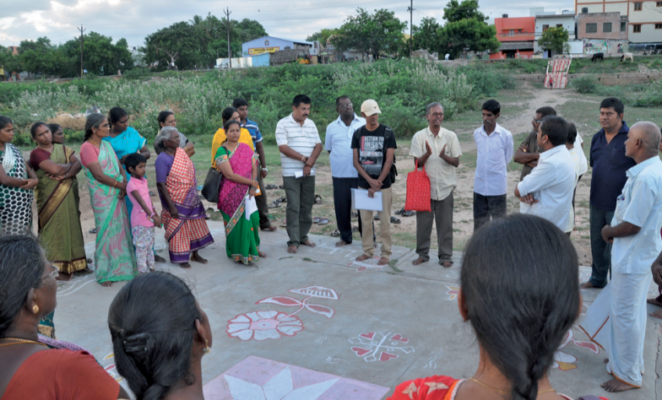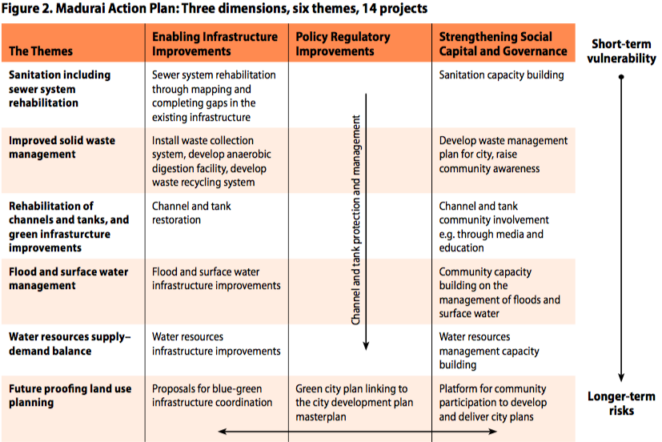Case-study /
Future Proofing of an Indian City – Lessons from Madurai

Introduction
Future proofing Indian cities is an innovative approach that engages multiple stakeholders in strengthening the blue-green infrastructure of cities in the context of urbanisation and climate change. Blue-green infrastructure includes both natural and manmade infrastructure covering the hydrological or ‘blue infrastructure’, and land-based natural habitats, ecosystems and urban green space or ‘green infrastructure’.
Atkins, a consultancy firm, has implemented the Future Proofing Cities project in partnership with the Development and Planning Unit at University College London (UCL) and the UK’s Department for International Development (DFID). In the city of Madurai in Tamil Nadu, the DHAN Foundation is the delivery partner to support the Madurai City Corporation in future proofing local development plans.
This ‘Inside Story on Climate Compatible Development’* explores how the DHAN Foundation, city government and others have overcome challenges to ‘future proof’ Madurai. The story focuses especially on the Foundation’s efforts to engage citizens in preparing and delivering the action plan for blue-green infrastructure.
*download available from the right-hand column.
Methods and Tools
Madurai is the second largest city in the state of Tamil Nadu, India. The city faces a range of climate-related hazards – particularly flooding. The flooding in Madurai is due to the blockage of storm water carriers and encroachment by slum communities around water bodies; these communities are also the worst-hit victims of the flooding.
The integrated assessment framework developed for the Future Proofing Cities project by Atkins in partnership with UCL and DFID was used to understand the interrelated issues arising from the risks and vulnerabilities which impact future development, and to prepare the Madurai Action Plan for Blue-Green Infrastructure (see Box 1 on page 3 of the report for explanation).
The Action Plan developed using this framework had the following objectives:
- To evolve priority themes based on the range of issues identified by multiple stakeholders.
- To identify short-, medium- and long-term programmes of inter- related actions for strengthening blue-green infrastructure.
- To make a case for mobilisation of resources for funding the projects, including assigning roles and responsibilities for each element of the Action Plan to different implementing institutions.
Themes and projects
In response to the issues identified as priorities by the stakeholders, 14 projects were developed relating to six themes across three dimensions (see Figure 2 below). Each project proposal described the issues to be addressed, the desired outcome or goal, the key actions to be taken, the sub- components, budget, benefit/impact score card and details of how the project would be delivered. Many of the proposals have the potential to deliver climate change mitigation benefits as well as addressing climate risks.
Exploring funding and partnerships for implementation
Engagement with donors who could support large-scale action was initiated by sharing the Action Plan with them with a view to mobilising support for projects identified in the plan. A resolution has also been made for Madurai to apply to participate in the 100 Resilient Cities programme supported by the Rockefeller Foundation (which would unlock funds and technical support to build resilience).
Enabling Factors
Several key factors contributed to the process of successfully arriving at a complete, agreed Action Plan (see the full text for more detail and examples):
- Building a shared vision among diverse groups:Building different platforms for engagement at the subnational level has been critical to developing a shared vision reflecting the needs and aspirations of all stakeholders. In contrast to the usual top-down, expert-dominated approach to priority-setting and strategising, participatory cross-sectoral forms of decision-making were pioneered.
- Using convincing evidence to mobilise for change:In the context of data inadequacy, engaging stakeholders was useful to synthesise a range of issues as part of the urban diagnosis. For example, interconnections between existing patterns of vulnerability in the city were reflected in the incidence rates of vector-borne diseases in areas that were not serviced with piped water.
- Endorsement of the Action Plan:The Action Plan has been endorsed both at the city level, by the Madurai Municipal Corporation with the local councillors, and at the state level during a round table, resulting in a commitment to explore all potential funding options.
- Legal action:Unexpected support has been received during the project period from the Madras High Court bench in response to the public interest litigation petitions filed by an advocate, to clear encroachments and clean up the Vaigai and Kiruthumal rivers.
- Social capital:Building social capital around water bodies was one of the projects proposed and has become a reality with the formation of the Zonal Council, which has a mandate to restore the rivers to their natural state, and with the institutionalisation of the water walks. The water walks now take place every two weeks, and enable the city administration and the line departments to take effective action, build trust with the communities and generate local knowledge on blue-green infrastructure. Sustaining the interest of stakeholders through arts and cultural events, such as the Vaigai River Pageant, has resulted in reviving the age-old relationship between the community and the river and brought all stakeholders together.

Lessons Learnt
Key lessons from the project include:
- Strengthening the blue-green infrastructure – the intricately networked water systems together with land-based habitats and natural ecosystems – is an effective way of reducing the impacts of climate change in the city of Madurai, India. Madurai’s experience suggests that to deliver such an approach effectively, it is vital to engage multiple stakeholders to diagnose and prioritise issues and explore a range of actions.
- Intermediary organisations are essential for assisting government and communities in future proofing, because intermediaries can build platforms for stakeholder engagement at the provincial and urban local body levels. The Development of Humane Action (DHAN) Foundation has played such an intermediary role in Madurai.
- Future proofing calls for building a case to secure resources from the local to the global level, using available evidence and testimonies.
- It also calls for building the capacities of stakeholders – across government authorities, civil society organisations, the private sector and communities – to bring about effective, experience-based engagement, to leverage norms and rules, and to develop a common and shared mission. Such a multi-faceted approach also improves the chances that future proofing plans made together will be delivered and sustained.
- The future proofing process also highlights how a programmatic approach to designing projects to address multiple interlinked issues can be effective in simultaneously delivering wider co-benefits. For example, alleviating flood risk through establishing a green space network can provide space for flood water on a temporary basis while addressing deficiencies in urban green space, which will thus be available during times when there is no flooding.
Suggested Citation
Madhan Kumar*, A. and Vasimalai*, M.P. (2016) Future Proofing of an Indian City: Lessons from Madurai. CDKN Inside Story. Climate and Developmet Knowledge Network: London, UK.
*DHAN Foundation

